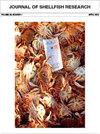An Estimate of Carbon Storage Capabilities from Wild and Cultured Shellfish in the Northwest Atlantic and Their Potential Inclusion in a Carbon Economy
IF 1
4区 农林科学
Q3 FISHERIES
引用次数: 0
Abstract
ABSTRACT Bivalve mollusc production has been proposed as a method to reduce carbon emissions as (1) a low-emission protein source, and (2) via carbon stored in their shells. Numerous studies have examined the fate of carbon in bivalve production, estimated carbon sequestration rates, and their role in a carbon economy. To address the fate of shell carbon for the Northwest Atlantic, stored oceanic carbon equivalents (Eq), released CO2via calcification, and hypothetical carbon credit value ($24 tCO2), for both aquacultured and wild-captured bivalves for New England and Canadian Provinces on the Atlantic between 2016 and 2020 were estimated. Bivalve shells do not sequester atmospheric CO2, instead storing oceanic CO2 Eq and cannot be directly included in a carbon sequestration scheme. In the present study, total annual estimates of stored oceanic CO2 Eq were approximately 202,253 and 363,243 tons, with concurrent releases of approximately 121,255 and 217,771 tons of CO2 to the atmosphere, of which only 4% and 8% were from aquaculture production in Canada and the United States, respectively. Even if bivalve shells sequestered atmospheric CO2, current shellfish production levels are inconsequential with regard to current anthropogenic greenhouse gas (GHG) emissions. Stored oceanic carbon Eq for bivalve aquaculture is equivalent to 0.001% and 0.0005% of Canadian and US annual anthropogenic CO2 emissions, whereas wild-capture would store 0.028% and 0.005% of Canadian and US emission, respectively. Bivalve shell will not solve climate change, but the expansion of bivalve production provides a protein source with the lowest GHG emissions, which provides a multitude of environmental services.西北大西洋野生和养殖贝类的碳储存能力及其在碳经济中的潜在包容性
双壳类软体动物的生产被认为是一种减少碳排放的方法,因为(1)它是一种低排放的蛋白质来源,(2)它通过壳中储存的碳来减少碳排放。许多研究调查了双壳类生物生产中碳的命运,估计了碳固存率,以及它们在碳经济中的作用。为了解决西北大西洋贝壳碳的命运,估计了2016年至2020年间大西洋新英格兰和加拿大省份水产养殖和野生捕获双壳类的海洋碳当量(Eq),通过钙化释放的二氧化碳,以及假设的碳信用价值(24亿吨二氧化碳)。双壳类不封存大气中的二氧化碳,而是封存海洋中的二氧化碳当量,因此不能直接纳入碳封存计划。在本研究中,海洋储存二氧化碳当量的年估计总量约为202,253吨和363,243吨,同时向大气释放的二氧化碳约为121,255吨和217,771吨,其中分别只有4%和8%来自加拿大和美国的水产养殖生产。即使双壳类能隔绝大气中的二氧化碳,目前的贝类生产水平与目前人为温室气体(GHG)排放相比也是微不足道的。双壳类水产养殖储存的海洋碳当量相当于加拿大和美国每年人为二氧化碳排放量的0.001%和0.0005%,而野生捕捞将分别储存加拿大和美国排放量的0.028%和0.005%。双壳贝类不能解决气候变化问题,但扩大双壳贝类生产提供了一种温室气体排放量最低的蛋白质来源,从而提供了多种环境服务。
本文章由计算机程序翻译,如有差异,请以英文原文为准。
求助全文
约1分钟内获得全文
求助全文
来源期刊

Journal of Shellfish Research
生物-海洋与淡水生物学
CiteScore
2.30
自引率
0.00%
发文量
40
审稿时长
6 months
期刊介绍:
Original articles dealing with all aspects of shellfish research will be considered for publication. Manuscripts will be judged by the editors or other competent reviewers, or both, on the basis of originality, content, merit, clarity of presentation, and interpretations.
 求助内容:
求助内容: 应助结果提醒方式:
应助结果提醒方式:


